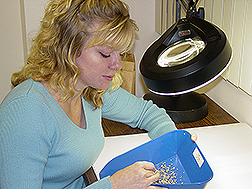This page has been archived and is being provided for reference purposes only. The page is no longer being updated, and therefore, links on the page may be invalid.
Read the magazine story to find out more. |
|
Preserving the Grain Crop Finger Millet
By Sharon DurhamApril 6, 2005
Seeds of finger millet, a staple grain in parts of Africa and India, are now being preserved and studied by Agricultural Research Service scientists as part of the continuing effort to maintain genetic diversity in agricultural crops.
ARS agronomist Melanie Newman, the curator for finger millet and other warm-season cereal, forage and turf grasses, maintains a wide variety of species in the agency's collection. The ARS Plant Genetic Resources Conservation Unit in Griffin, Ga., houses the finger millet collection, along with over 83,400 samples of other agricultural crops.
According to Newman, it's crucial to agriculture to maintain a collection with key genetic traits. She and plant geneticist Ming Li Wang are busy genetically fingerprinting the germplasm in the collection to provide researchers with a set of genetic markers needed to evaluate germplasm and identify various traits. Yield and resistance to a fungal disease called blast are important for growing finger millet as a food crop.
Maintaining the collection is vital to future research on finger millet. Researchers have to retain an adequate amount of seed from each sample, or accession. The seeds stored at the Griffin facility are germinated in specialized chambers, grown in pots in the greenhouse and finally placed in the field. The seeds from these plants are then preserved for future use.
Newman also receives requests for finger millet for nutritional studies to increase its utility as a food staple in developing countries.
Read more about this research in the April issue of Agricultural Research magazine.
ARS is the U.S. Department of Agriculture's chief scientific research agency.

